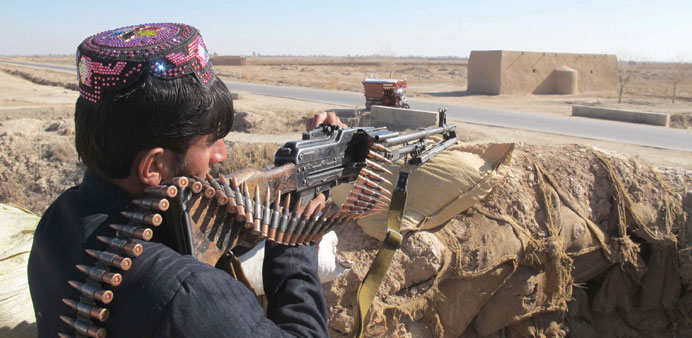An Afghan Local Police (ALP) personnel keeps watch during an ongoing battle with Taliban militants in the Marjah district of Helmand Province in this December 23 photograph.
AFP
Kabul
The US launched air strikes to bolster Afghan forces scrambling yesterday to beat back Taliban insurgents who seized large swathes of a key opium-rich district, following the first British deployment to the volatile region in 14 months.
The Islamists claim to have captured nearly the entire district of Sangin after storming its frontlines on Sunday, tightening their grip on the southern Helmand province.
Fleeing residents reported Taliban executions of captured soldiers as the insurgents advanced on the district centre, compounding fears that the entire province was on the brink of falling into insurgent hands.
The US army conducted air strikes on Wednesday to bolster Afghan forces mobilising reinforcements to relieve dozens of security forces holed up in the district centre.
“US forces conducted two strikes in Sangin,” a Nato spokesman said in a brief statement.
Taliban spokesman Zabiullah Mujahid said insurgents had overrun the whole of Sangin, pinning down Afghan forces in a military base where trapped soldiers reported dire conditions.
“Our men are hungry and thirsty,” Abdul Wahab, a local police commander in Sangin, said.
“Stepping out to get bread means inviting death,” he said, adding that dozens of his comrades had been killed and critically wounded.
The war in Helmand, seen as the epicentre of the expanding insurgency, follows a string of military victories for the Taliban after Nato formally ended its combat operations last year.
All but two of Helmand’s 14 districts are effectively controlled or heavily contested by the Taliban, who also recently came close to overrunning the provincial capital Lashkar Gah.
The turmoil in Helmand, the deadliest province for British and US forces in Afghanistan over the past decade, underscores a rapidly unravelling security situation in Afghanistan.
Britain on Tuesday said a small contingent of its troops had arrived in Camp Shorabak, the largest British base in Afghanistan, before it was handed over to Afghan forces last year.
The deployment, in addition to a recent arrival of US special forces in the region, is the first since British troops ended their combat mission in Helmand in October 2014.
The contingent, which an Afghan official said includes around 90 people, is on an “advisory” mission with London insisting they will not engage in combat.
The British and US intervention has fuelled the perception that foreign powers are increasingly being drawn back into the conflict as Afghan forces struggle to rein in the Taliban.
The unrest in Helmand, blighted by a huge opium harvest that helps fund the insurgency, comes after the Taliban briefly captured Kunduz city in September — their biggest victory in 14 years of war.
“Sangin signifies another humiliating defeat for Nato-trained Afghan forces,” security analyst Mia Gul Waseeq said.
“Since the Nato drawdown last year, the Taliban have gone from strength to strength.”
President Barack Obama in October announced that thousands of US troops would remain in Afghanistan past 2016, acknowledging that Afghan forces are not ready to stand alone.
Afghan President Ashraf Ghani has sought to mend ties with longtime regional nemesis Pakistan — the Taliban’s historic backers — in a bid to restart peace talks with the insurgents.
Pakistan hosted a first round of negotiations in July but the talks stalled when the Taliban belatedly confirmed the death of longtime leader Mullah Omar.
A security official in Islamabad told said that Pakistan army chief Raheel Sharif would travel to Kabul in the coming days, in what appears to be a renewed push to jumpstart talks.
Afghanistan’s spy agency chief resigned this month after a scathing Facebook post that vented frustration over Ghani’s outreach to Pakistan.
Rahmatullah Nabil’s resignation raised uncomfortable questions about a brewing leadership crisis in Afghanistan as the insurgency gains new momentum.



